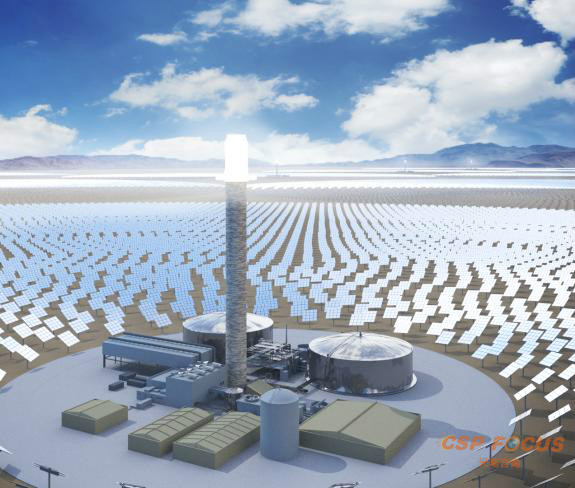Home > Market > Other Regions > Here
America’s Concentrated Solar Power Companies Have All but Disappeared
2020.01.21 From: HELIOSCSP
SolarReserve, one of America’s last remaining Concentrated Solar Power developers, appears to have ceased operations — just as some global markets may be warming up.

The Crescent Dunes CSP project in Nevada has undershot expectations. (Credit: SolarReserve)
There are fears for one of America’s last two remaining concentrated solar power developers as the embattled sector attempts to pivot to a new business model abroad.
SolarReserve, which developed the 110-megawatt Crescent Dunes concentrated solar power (CSP) plant in Nevada, is thought to have halted operations after losing its only income-generating U.S. contract and selling foreign projects including Aurora in Australia and Likana in Chile last year.
The company could not be reached by email or phone this month, and its website was no longer active. Industry veteran Luis Crespo, president of Spanish CSP association Protermosolar, told GTM he believes SolarReserve is no longer operational and its assets have been sold off as part of a liquidation.
Kevin Smith, SolarReserve’s long-time CEO, took a job a year ago as CEO for the Americas at Lightsource BP, according to his LinkedIn profile.
Santa Monica, California-based SolarReserve lost the income from its only U.S. power-purchase agreement, with the Berkshire Hathaway-owned Nevada state utility NV Energy, last October, according to a lawsuit filed at the time. NV Energy had agreed to buy electricity from Crescent Dunes up until 2040 but broke off the contract over performance failures at the plant.
Crescent Dunes was developed with $737 million in U.S. Department of Energy loan guarantees and run by a SolarReserve-linked entity called Tonopah Solar Energy. SolarReserve’s October lawsuit claimed the Department of Energy had gained control of Tonopah’s board in a bid to close Crescent Dunes after receiving NV Energy’s default notice.
The move “exposes SolarReserve’s equity to the uncertainty of a Tonopah bankruptcy filing,” said the suit at the time.
But problems at Crescent Dunes were nothing new. Commissioned in 2015, the plant never managed to achieve its average expected monthly output, according to a late-2019 market outlook from Bloomberg New Energy Finance. And last August, S&P Global Platts said the plant had only achieved a 0.3 percent capacity factor in the second quarter of 2019, delivering a paltry 765 megawatt-hours of power to the grid.
One of the highest-profile failures at Crescent Dunes was an eight-month shutdown caused by a leak in the plant’s molten salt thermal storage tank.
SolarReserve’s lawsuit blamed the leak on ACS Cobra, a Spanish company that carried out the engineering, procurement and construction work for Crescent Dunes. This accusation was echoed by Bill Gould, SolarReserve’s former chief technology officer, in a Bloomberg story this month.
ACS Cobra did not respond to a request for comment.
Crescent Dunes may well end up back in long-term service, though it remains to be seen who would want to take control of the plant.
CSP has developed a bad reputation in the U.S., not just because of problems at Crescent Dunes but also from low capacity factors overall and largely exaggerated reports of bird deaths at power-tower plants such as those developed by SolarReserve and another U.S. firm, BrightSource Energy.
But the biggest challenge facing CSP, not just in the U.S. but also in the rest of the world, is the plummeting price of solar PV.
America’s lost CSP leadership
BloombergNEF figures show the cost of U.S. utility-scale PV plunging over the last decade, from $355 per megawatt-hour in 2009 to $51 per megawatt-hour last year.
The price decrease means U.S. offtakers can get solar energy from new PV plants at around 38 percent of the $135 per megawatt-hour cost that was agreed upon for Crescent Dunes. And the cost differential keeps growing as PV gets cheaper.
This growing price disparity has made life increasingly difficult for CSP developers, decimating America’s once-leading capability in the field.
SolarReserve’s apparent demise means BrightSource is now the only experienced plant developer in the country that was the birthplace of CSP, after Burbank-based eSolar disappeared sometime in 2017 (one other U.S. firm, GlassPoint, builds process heat plants only).
Even BrightSource, which developed the 377-megawatt Ivanpah Solar Electric Generating System complex in the Mojave Desert, is keeping a low profile in the U.S. these days. The company’s Oakland telephone number went straight to voicemail, and the latest announcement on its website dates from 2017.
BrightSource is understood to have refocused its efforts on foreign markets, and particularly the development of a 121-megawatt project called Ashalim in the Negev desert of Israel.
The foreign focus could prove fortuitous for America’s sole remaining CSP developer; while the technology has clearly fallen from favor in the U.S., it is starting to see an uptick in interest in several overseas markets.
This month saw Chile connecting Latin America’s largest CSP plant, Cerro Dominador, to the grid. CSP is also part of the energy mix in South Africa and, increasingly, Middle Eastern and North African markets such as Dubai and Morocco.
CSP is just as susceptible to competition from PV in these markets as it is in the U.S. But in a growing number of projects, CSP is not aiming to compete with PV.
Instead, developers are being tasked with building plants that will act as huge batteries, storing daytime heat in massive molten salt tanks that can then be used to power the grid after sundown.
A resurgent Spanish CSP market?
South Africa pioneered this idea with an auction structure that gave CSP plants a 270 percent above-base-rate bonus for delivering power during late afternoon and evening hours, although problems with the country’s sole offtaker, Eskom, led to build-out delays that took the shine off the program.
More recently, other regulators have followed suit in looking at CSP as a form of energy storage rather than direct generation. In Dubai, for example, a hybrid CSP and PV plant called Noor Energy 1 is being built with 550,000 tons of molten salt storage, the largest amount ever used in a solar project, to deliver nighttime electricity at $92 per megawatt-hour. Daytime PV output will reportedly cost $24 per megawatt-hour.
Even Dubai’s 700-megawatt CSP project pales in comparison to a plan currently being pondered in Spain, however.
Spain is already the world’s largest CSP market, with an installed base of between 2.3 gigawatts and 2.5 gigawatts of generation capacity (the former estimate is from Protermosolar and the latter is from BloombergNEF).
It also has, arguably, the world’s most reliable CSP fleet, with production increasing last year to cover almost 2.7 percent of Spain’s electricity demand in the first eight months of 2019, according to Protermosolar. And that is despite having plants operating that are now over a decade old.
Based on this experience, Spain’s 2021-2030 National Energy and Climate Plan, submitted to European Union officials last year, envisages installing another 5 gigawatts of CSP capacity to help achieve carbon-emission reduction targets.
Crespo said all of this added capacity would be dedicated to storing solar energy for overnight use, substituting coal and gas and completely avoiding any competition with PV.
What’s more, the CSP plants would use PV panels to power daytime energy use, maximizing the amount of energy going to storage, Crespo said.
Spain’s CSP plans may not seem much in terms of solar growth — Wood Mackenzie estimates the U.S. alone saw 13 gigawatts of PV installations last year, for instance. But for the CSP market, a 5-gigawatt increment is immense, equal to a roughly 73 percent increase on today’s global installed capacity.
And since each gigawatt of new CSP would be tied to molten salt stores delivering energy over nine hours, in storage terms the plan would far outstrip all the utility-scale and behind-the-meter battery capacity deployed worldwide in 2018, based on International Energy Agency data.
Whether Spain will end up tendering 5 gigawatts of new CSP is still unclear, since the country has recently carried out elections and has yet to release details of forthcoming energy policies.
Furthermore, given CSP’s checkered past in many markets, some observers are hesitant to predict its chances of being included in upcoming energy tenders.
“As far as I know, all further solar thermal support is pure rumor at this stage, and I tend to discount it,” said Jenny Chase, head of solar analysis at BloombergNEF.
However, Spain’s new coalition government is seen to be pro-renewables and is led by the party that submitted the National Energy and Climate Plan last year. Because of this, Crespo said that a CSP tender might take place as early as March or April.
If it does, then the next problem facing the industry is which companies might credibly respond to the tender. Fortunately for Spain, most of the big CSP developers still left in the world are Spanish, led by players such as Abengoa, Sener and TSK Energy Solutions.
But the field is not exactly brimming with contenders. And the size and complexity of CSP projects means companies in the industry ecosystem often have to collaborate with each other to get the job done. At least 15 firms are working on Noor Energy 1, including BrightSource for tower technology and Abengoa for trough design.
Whether a restricted pool of suppliers can service a 5-gigawatt tender, let alone create enough competition to drive down costs, is very much an open question.
One thing is certain, though: If Spain decides to bet on CSP as a gigawatt-scale source of energy storage, there is now little chance that U.S. companies could reap the spoils.
Upcoming CSP events:
10th CSP Focus China 2020 (March.25-26, Beijing China)
5th CSP Focus MENA 2020(June.23-24,Dubai, UAE)
More CSP news and reports please visit www.cspfocus.cn
or CSP Focus social media on LinkedIn, Twitter, Facebook.
More from CSP Focus
NextContourGlobal in talks with Iberdrola to acquire Spanish concentrated solar power plant
Phase Four of Mohammed bin Rashid Al Maktoum Solar Park 30% complete says DEWA
Sbps joins three solar themal power projects in China with innovative CSP collectors
Cloud camera system WobaS provides concentrated solar power plants with reliable radiation nowcasts
Final Agenda Released! See you at CSP Focus China 2018 Mar.22-23 Beijing
Fire halts construction at Chile’s first Concentrated Solar Power tower
Speakers wanted! Come and share with MENA concentrated solar power players
Concentrated solar power tower exposes materials to intense heat to test thermal response
African Development Bank to provide US$265 million loan to 800MW Moroccan solar project
Leave your thoughts here
Reports(Member Only)
See more+-
CSP Focus Membership Proposals
We are now proposing CSP Focus Membership, hoping to better serve our members to keep pace with the latest updates of ongoing CSP projects worldwide, and to establish and maintain business relations with major shareholders of the projects. CSP Focus offers to Membership exclusive access to:1. Daily/Weekly update and analysis on CSP policies, projects, technologies, market trend and corporate relea
-
The Latest CSP Focus Monthly Update
Join CSP Focus Membership to Get the Latest CSP Focus Monthly Update December Edition.
-
CSP Project Monthly Update 2022 December Edition
CSP Focus is presenting CSP Project (China) Update 2022 December Edition.Detail report is available for CSP Focus Membership.
-
Presentations-CSP Focus China 2021
The Report is for CSP Focus Members only.
Upcoming Events
See more+-
12th CSP Focus China 2022
2022.04.21-22 Beijing
-
11th CSP Focus China 2021
2021.10.28-29 Beijing
-
10th CSP Focus China 2020
2020.10.22-23 Beijing, China
Project Updates
See more+-
Lanzhou Dacheng Dunhuang CSP Project
Asia Pacific-China,Operational,Parabolic Trough
-
Luneng Haixi 50MW Molten Salt Tower CSP Project
Asia Pacific-China,Operational,Power Tower
-
Dubai 950MW NOOR Energy 1 CSP+PV Project
MENA-UAE,Under construction,Power Tower
-
Power China Gonghe 50MW Molten Salt Tower CSP Project
Asia Pacific-China,Operational,Power Tower





